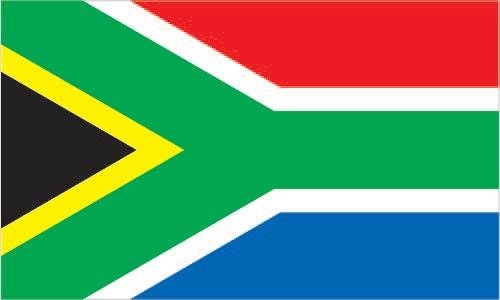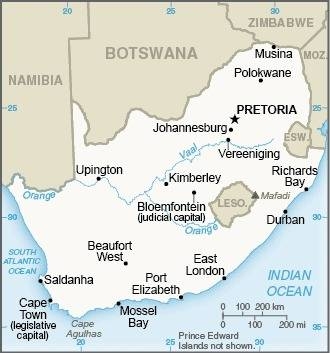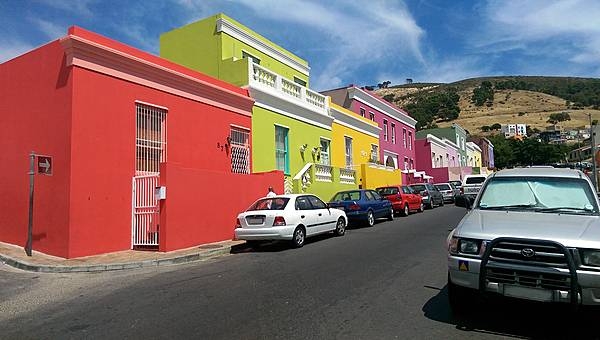222 South Africa

Two equal width horizontal bands of red (top) and blue separated by a central green band that splits into a horizontal Y, the arms of which end at the corners of the hoist side. The Y embraces a black isosceles triangle from which the arms are separated by narrow yellow bands. The red and blue bands are separated from the green band and its arms by narrow white stripes. The flag colors do not have any official symbolism, but the Y stands for the “convergence of diverse elements within South African society, taking the road ahead in unity”. Black, yellow, and green are found on the flag of the African National Congress, while red, white, and blue are the colors in the flags of the Netherlands and the UK, whose settlers ruled South Africa during the colonial era.
Flag courtesy of the CIA World Factbook

Map courtesy of the CIA World Factbook

Buildings in the Bo-Kaap District in Cape Town with very brightly painted exteriors.
Photo courtesy of the CIA World Factbook
Government
According to Britannica, South Africa’s original constitution, the British Parliament’s South Africa Act of 1909, united two former British colonies, the Cape of Good Hope and Natal, with two former Boer (Dutch) republics, the Transvaal and Orange Free State. The new Union of South Africa was based on a parliamentary system with the British monarch as head of state. The Republic of South Africa Constitution Act of 1961 transformed the country from a dominion within the British Commonwealth into an independent republic.
South Africa’s political development was shaped by its colonial past and the implementation of apartheid policies by the white minority. After widespread protest and social unrest, a new nonracial interim constitution was adopted in 1993 and took effect in 1994. A new, permanent constitution, mandated by the interim document and drafted by Parliament in 1996, took effect in 1997.
The 1909 South Africa Act served as the country’s constitution until 1961. When South Africa officially became a republic in 1961, a constitution was finally written. In addition to providing for the already established positions of president and prime minister, the constitution gave Coloreds and Asians some voting rights. A new constitution was promulgated in 1984. The bicameral parliament was replaced by a tricameral system that created a House of Assembly for whites, a House of Representatives for Coloreds, and a House of Delegates for Indians. The Black majority was given few political rights in either constitution.
The 1996 constitution’s preamble points to the injustices of South Africa’s past and defines the republic as a sovereign democratic state founded on the principles of human dignity, non-racialism and non-sexism, and the achievement of equality and advancement of human rights and freedoms. Another of the guiding principles, that of “cooperative government,” emphasizes the distinctiveness, interdependence, and interrelationship of the national, provincial, and local spheres of government. The constitution established the bicameral national Parliament. The lower house, or National Assembly, comprises 350 to 400 members who are directly elected to a five-year term through proportional representation. The National Council of Provinces, which replaced the Senate as the upper house, is made up of 10-member delegations (each with six permanent and four special members, including the provincial premier) chosen by each of the provincial assemblies. For most votes each delegation casts a single vote. The president, elected from among the members of the National Assembly by that body, is the head of state; as the national executive, the president presides over a cabinet that includes a deputy president and a member whom the president designates as the “leader of government business” in the assembly.
Local government was established in 1909 when the four former colonies became provinces. Each was governed by a white-elected provincial council with limited legislative powers. The administrator of each province was appointed by the central government and presided over an executive committee representing the majority party in the council. Provincial councils were abolished in 1986, and the executive committees, appointed by the president, became the administrative arms of the state in each province. By the late 1980s a small number of Blacks, Coloreds, and Indians had been appointed to them.
In 1994 the four original provinces of South Africa (Cape of Good Hope, Orange Free State, Transvaal, and Natal) and the four former independent homelands (Transkei, Bophuthatswana, Venda, and Ciskei) were reorganized into 9 provinces: Western Cape, Northern Cape, Eastern Cape, North-West, Free State, Pretoria-Witwatersrand-Vereeniging (now Gauteng), Eastern Transvaal (now Mpumalanga), Northern (now Limpopo), and KwaZulu-Natal. The constitution provides for the election of provincial legislatures comprising 30 to 80 members elected to five-year terms through proportional representation. Each legislature elects a premier, who then appoints a provincial executive council of up to 10 members. The provincial legislatures have the authority to legislate in a range of matters specified in the constitution, including education, environment, health, housing, police, and transport, although complex provisions give the central government a degree of concurrent power. South Africa thus has a weak federal system.
Urban municipal government has developed unevenly in South Africa since the early 19th century. In the 20th century, intensified urban segregation was accompanied by the creation of councils that advised the administrators appointed by white governments to run Black, Colored, and Asian “locations” and “townships.” In most rural areas, white governments tried to incorporate indigenous hereditary leaders (“chiefs”) of local communities as the front line for governing Blacks, although the Cape administration also set up a parallel system of appointed “headmen.”
Under the 1996 constitution, local government is predicated on a division of the entire country into municipalities. Executive and legislative authority is vested in municipal councils, some of which share authority with other municipalities. Chiefs remain important in rural governance. They generally work with appointed councils regarded by their supporters as traditional. Efforts by other Blacks to reform and democratize rural administration and reduce the power of chiefs have become some of the most violently contentious issues in post-apartheid politics.
The common law of the republic is based on Roman-Dutch law, the un-codified law of the Netherlands having been retained after the Cape’s cession to the United Kingdom in 1815. The judiciary comprises the Constitutional Court (with powers to decide on the constitutionality of legislative and administrative actions, particularly with respect to the bill of rights), the Supreme Court of Appeal (the highest court of appeal except in constitutional matters), the High Courts, and Magistrate’s Courts. Parliament may create additional courts but only with status equal to that of the High and Magistrate’s Courts. The Supreme Court is headed by a chief justice, who is appointed by the state president, as are the deputy chief justice and the chief justice and deputy chief justice of the Constitutional Court. Other judges are appointed by the president with the advice of the Judicial Service Commission.
Traditional authorities exercise some powers in relation to customary law, which derives from indigenous African practice codified in some areas (such as KwaZulu-Natal) by colonial rulers. Customary law continues to be recognized in various ways. For example, marriage in South Africa takes place either under customary law or under statute law, with profound implications for the legal status of African women married under customary law. Most civil and criminal litigation is a matter for the Magistrate’s Courts.
South African Civil Aviation Authority (SACAA)
The South African Civil Aviation Authority (SACAA) is an agency of the Department of Transport (DoT), established on 01 October 1998, following the enactment of the now repealed South African Civil Aviation Authority Act, 1998 (Act No. 40 of 1998). This Act was replaced by the Civil Aviation Act, 2009 (Act No. 13 of 2009), which came into effect on 31 March 2010. As outlined in the Public Finance Management Act (PFMA), 1999 (Act No. 1 of 1999) (as amended by Act No. 29 of 1999), the SACAA is a Schedule 3A public entity. The PFMA designates the SACAA’s Board of Directors as the organization’s Accounting Authority responsible for governance, while the Minister of Transport is the Executive Authority.
The Civil Aviation Act provides for the establishment of a stand-alone authority, mandated with controlling, promoting, regulating, supporting, developing, enforcing, and continuously improving levels of safety and security throughout the civil aviation industry. The above is achieved by complying with the Standards and Recommended Practices (SARPs) of the International Civil Aviation Organization (ICAO), while considering the local context. The SACAA, through a Ministerial order, is mandated with the administrative functioning of the aircraft Accident and Incident Investigation Division (AIID), while the Department of Transport is responsible for the functional running of this unit. At the time of establishment, the SACAA was also tasked with the running of the Flight Inspection Unit, whose aim is to conduct calibration and flight inspection of ground radio navigational aids in South Africa and beyond.
Airspace
SkyVector – Google Maps – ADS-B Exchange
ICAO countries publish an Aeronautical Information Publication (AIP). This document is divided into three parts: General (GEN), En Route (ENR) and Aerodromes (AD). ENR 1.4 details the types of airspace classes they chose to adopt from classes A through G.
Drone Regulations
South African National Park Rules – The use of drones inside (and over) national parks is strictly prohibited.
The Aviation4SA App – for navigating the constantly changing, complex legislative environment.
Advanced Air Mobility (AAM) Regulations & Policies
Bilateral agreements facilitate the reciprocal airworthiness certification of civil aeronautical products imported/exported between two signatory countries. A Bilateral Airworthiness Agreement (BAA) or Bilateral Aviation Safety Agreement (BASA) with Implementation Procedures for Airworthiness (IPA) provides for airworthiness technical cooperation between the FAA and its counterpart civil aviation authorities.
Bilateral Airworthiness Agreement (Including Agreement)
Revised Export Documentation Requirement For Engines And Propellers
2016 Notification of Policy Deviation Memorandum for FAA Order 8130.21H
Obtaining Certification Approval from this Country
Advanced Air Mobility (AAM) News
2025
Video courtesy of Advanced Air Mobility Institute from the July 2025 Global AAM Forum.
2025
Video courtesy of Advanced Air Mobility Institute from the January 2025 Global AAM Forum. Complete session for Day 2 of this Forum is available on the Advanced Air Mobility Institute YouTube Channel
Short Essay Questions
Scenario-Based Question
You have been hired by a Drone Startup Company. Your boss has immediately assigned this job to you.
They need you to prepare a one-page memo detailing the legalities of using a drone to film in Cape Town.
They need you to mention any national laws and local ordinances.
They specifically want to know what airspace (insert pictures) you will be operating in and whether or not you need an airspace authorization.
Does it matter whether or not you are a citizen of the country?
Lastly, there is a bonus for you if, as you scroll through this chapter, you find any typos or broken links!
Short Essay Questions
- What are the drone categories?
- How is registration addressed?
- How is remote ID addressed?
- What are the model aircraft rules?
- What are the commercial drone rules?
- Are there waivers or exemptions to the rules? If so, for what?
- Would you share a link to an interactive airspace map?
- How is BVLOS addressed?
- How can you fly drones at night?
- How can you fly drones over people?
- Where do you find drone NOTAMs?
- What are the rules for drone maintenance?
- What are the rules for an SMS program?
- What are some unique rules not mentioned above?
- What are the C-UAS rules?
- What are the AAM rules?

